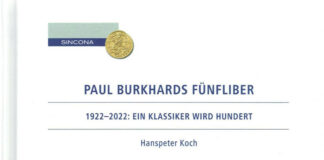
It’s a wonderful academic custom to publish a Festschrift as a present for a special anniversary. If we are to believe the omniscient Wikipedia, the first of these commemorative publications is said to have been published as early as in 1640, on the occasion of the 200th anniversary of the invention of letterpress printing. Since then, this originally German tradition – by means of which students honour their teacher and demonstrate at the same time how manifold the research he or she initiated is – has spread all over the world. That’s the reason why the German word Festschrift is also used in English and Spanish to describe these commemorative publications.
In order for a Festschrift to be successful, it’s of particular importance that the work wasn’t published solely for the sake of publishing but is directly linked to the honoured person. So let’s put SINCONA AG’s Festschrift to the ultimate test for such publications: to what extent does the Festschrift reflect what the company stands for?
On the Solid Grounds of Swiss Numismatics
Three of the ten articles are dedicated to Swiss coins and medals. In his unique popular scientific way, Dr Ruedi Kunzmann, a doyen of this discipline, presents an unpublished 1684 double ducat from Bern, the off-metal strike of a taler of the city of Zug and inflation medals of Zurich and Schaffhausen from 1817 and 1819.
Thus, the book clearly focuses on Swiss numismatics. And that is perfectly in line with SINCONA. After all, the auction house defines itself as a Swiss company committed to typical Swiss virtues: reliability, quality, diligence and being down to earth.
Two Contributions on Orders and Paper Money
However, SINCONA is more than just coins. The auction house is famous for its paper money and order auctions. The articles reflect that. Michael Autengruber contributed an article entitled “A Bear Called Annunziata” proving that the abbots of Saint Gall had themselves depicted on their coins with the collar of the Savoy Order of the Annunciation. An impressive demonstration of how closely numismatics and phaleristics are connected.
And Ruedi Kunzmann writes about – how fitting for a company housed in the premises of a former branch of the Zürcher Kantonalbank – an unpublished kassenschein of this very bank from 1870.
A Glance at Germany
SINCONA has three branches on German soil, thus, it shouldn’t come as a surprise that the Festschrift deals with German numismatics just as extensively as with Switzerland. Karl Weisenstein covers this field with an article on the coinage of the Electorate of Mainz in the 17th century and an article dedicated to three women who can be associated with important mints thanks to historical documents.
Kees Uitenbroek from the Netherlands bridges the gap to world issues with his contribution on a 15 rupee piece minted in 1916 for Tabora.
Francophile
Like all Swiss companies, SINCONA is Francophile, and those who prefer to speak French will always find someone there with whom they can communicate. And that’s why, of course, there is also a French article in the Festschrift. The recently deceased Marc Klein contributed a catalogue of the gold coins issued by the city of Strasbourg between 1508 and 1682.
This is perfectly in line with the long-standing, excellent relation between the Reformed cities of Zurich and Strasbourg. Do you know the story of the Zurich millet gruel transport? Every now and then, the people of Zurich used to bring a full pot of millet gruel to Strasbourg. Since the pot was still warm when they got there, they demonstrated how quickly they were to rush to the aid of the people of Strasbourg. Today, food transports are rather headed in the opposite direction. For with excellent Alsatian wine, even the most insipid Zurich gruel tastes great.
A Sidelong Glance at Antiquity
Yes, we know, SINCONA doesn’t specialize in antiquity, but you don’t have to do everything by yourself as long as you have friends to work with. Thus, Lars Rutten of Leu contributed an article on the motif of Midas in Roman provincial coinage.
The International Market
But where’s the international market? Where are Russia, China and the US, Poland, Great Britain and Italy? Where are all the countries where SINCONA has many customers thanks to the auction house’s wide range of products? Well, at least SINCONA had the Festschrift translated into English by Pressedienst Kampmann. But, of course, that cannot replace actual articles on these subjects.
We have to console ourselves with the fact that number was simply limited to ten articles for ten years. We have to wait for the 25th anniversary of the founding of SINCONA to see the next Festschrift. Then we can be sure that other fields will also be covered.
Congratulations on the 10th anniversary of SINCONA AG!
Click here to go to SINCONA AG.
We obviously dedicated an article to the 10th anniversary of the company.



